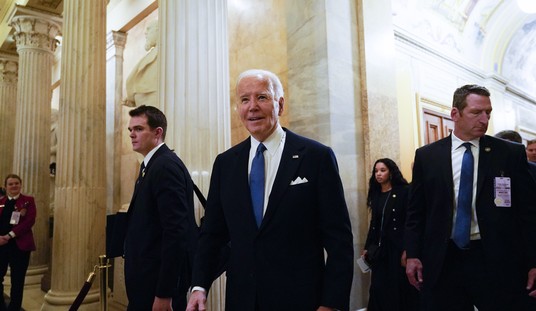Nine days ago (at this writing), Iraq War veteran and triple amputee Brian Kolfage launched a GoFundMe page to help build the wall on the United States southern border with Mexico. In a week and a half, Kolfage has raised over $17 million (toward his stated goal of $1 billion) with gifts from over 285,000 people.
The explosion of support for Kolfage’s grassroots fundraising has gotten a great deal of attention, not all of it positive, needless to say. On my own Facebook and Twitter feeds, I read many snarky posts to the effect of, “Oh, sure -- these people can give money for a wall but can’t donate funds to help (veterans/the poor/the disabled/fill in your cause of choice here).”
This -- like so many pronouncements on the shortcomings of Americans these days -- is not just false but a staggering distortion of reality. Perhaps because I teach entrepreneurship, I am well aware of America’s long history of philanthropy. America’s entrepreneurs have always been generous with their wealth -- and we have countless universities, civic institutions and medical facilities as proof. Americans as a rule are among the most generous people on Earth, giving to support hundreds and thousands of causes each year -- a fact that the esteemed Smithsonian noted when it launched its Philanthropy Initiative in 2015, by which its curators sought “to document, preserve, interpret, and exhibit ... the role of philanthropy in American history, as well as the role of Americans in encouraging and using philanthropy throughout the world.”
According to the Giving USA Foundation, which publishes an annual report of charitable giving, Americans gave over $410 billionin 2017, 2.1 percent of the nation’s gross domestic product. This was a record-breaking amount -- the first time that annual charitable giving crossed the $400 billion mark -- and substantially in excess of the $389 billion record set in 2016.
The report reveals other important data about Americans’ charitable inclinations and debunks popular myths propagated by those whose political machinations depend upon characterizing Americans as “selfish” and “greedy.” For example, individuals -- not foundations or even corporations -- constitute the largest number of givers, representing 70 percent of all gifts. Individual gifts increased by 5.2 percent in 2017 to an estimated $286.65 billion.
Recommended
That said, corporate giving increased by 8 percent to an estimated $20.77 billion, and $405 million of those funds was earmarked for victims of natural and manmade disasters.
Furthermore, Americans’ generosity is directed to an extraordinarily broad spectrum of causes. Eight of the nine types of charitable subsectors tracked by the Giving USA Foundation saw substantial increases in 2017: religious charities (up 2.9 percent), education (up 6.2 percent), human services (up 5.1 percent), health organizations (up 7.3 percent), public-society benefit organizations (up 7.8 percent), organizations that promote the arts, humanities and culture (up 8.7 percent), environmental and animal welfare organizations (up 7.2 percent) and foundations (up 15.5 percent).
Experts quoted by Giving USA cited the booming economy as a primary reason for the increase in giving in 2017 and predicted that the tax cuts that went into effect in 2017 would have a multiplier effect on giving in 2018 as well. Dr. Amir Pasic, the Eugene R. Tempel dean of the Lilly Family School of Philanthropy at IUPIU, said, “(S)ome of our most fortunate citizens are using their wealth to make some significant contributions to the common good.” In fact, 91 percent of high net worth individuals gave to charity last year -- at an average of over $25,509 per household.
This flies in the face of the popular sloganeering that Americans who benefit from tax cuts are greedy and want those less fortunate to suffer. Increased prosperity in the United States results in (SET ITAL) increased (END ITAL) generosity. (It’s worth mentioning here that while corporate pre-tax profits rose by 4.1 percent in 2017, corporate charitable giving rose by nearly double that percentage.)
But it is not only wealthy individuals and families who give generously; middle-class and lower-income Americans do as well. Average household giving among middle- and lower-income families was over $2,200 last year -- another record. Nor is it a white phenomenon: African-Americans, Hispanics, Asian-Americans and other minorities have a strong history of philanthropy in this country.
Keep in mind that the $410 billion figure cited above is for (SET ITAL) one year (END ITAL). Americans have given over $350 billion a year every year since 2014, over $300 billion a year since 2005 and over $200 billion since 2000, according to Giving USA. In other words, Americans have given over $5 trillion in charitable donations just since the year 2000.
Nor is it simply a matter of money. Last year, 63 million Americans -- 25 percent of the adult population -- donated their (SET ITAL) time, talents and energy (END ITAL) by volunteering for one or more charitable organizations of their choice. This, too, is a distinctly American tradition going back to the country’s founding (as author Alexis de Tocqueville famously observed in his book “Democracy in America,” published in two volumes between 1835 and 1840).
It should therefore be unsurprising that hundreds of thousands of Americans are willing to pony up for something as important as border security -- and further, that this priority does (SET ITAL) not (END ITAL) come at the expense of support for people’s many other needs.
2018 has been a tumultuous year, filled with propaganda and polemic. As the year comes to a close, look at your neighbors and countrymen through a kinder lens; we are much more generous than we give one another credit for.


